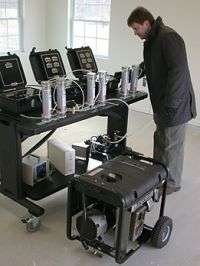NIST is working with the Consumer Product Safety Council (CPSC) to quantify the dangers of improperly used gasoline-powered portable generators and to evaluate possible technical solutions to the problem. Here, NIST researcher Steven Emmerich adjusts a multi-gas analyzer that will measure carbon monoxide, oxygen, carbon dioxide and hydrocarbons concentrations produced by such a generator located, against safety advice, in a garage. Credit: NIST
The same gasoline-powered portable generators that keep the lights burning, the freezer cold, and the house warm when a storm shuts off the electricity, can also kill you in minutes if you fail to follow safe practices.
A single generator can emit several hundred times more poisonous carbon monoxide than a modern car’s exhaust. To help quantify the dangers of improperly used portable generators, and evaluate possible technical solutions to the problem, the Consumer Product Safety Commission (CPSC) has enlisted the National Institute of Standards and Technology (NIST).
The CPSC recently mandated explicit labels warning consumers of the danger of carbon monoxide poisoning associated with operating a portable generator in or near a home. While observing that generators are useful in emergencies, the commission warns consumers not to use a generator inside homes, garages, crawlspaces, sheds or similar areas, even when using fans or opening doors and windows for ventilation.
Deadly levels of odorless and invisible carbon monoxide can quickly build up in those areas and can linger for hours, even after the generator has shut off, according to the commission, which received reports that at least 65 people died from carbon monoxide poisoning associated with portable generators in 2006. It can even be deadly to use a generator outside if its exhaust stream is too close to a home’s open doors, windows or air vents.
To learn more about the consequences of operating a gasoline-powered portable generator in the attached garage of a home, NIST researchers will collect data that quantifies carbon monoxide infiltration into a sensor-equipped house during different weather and house conditions.
They will look at effects of variable outdoor temperatures and wind speeds, as well as different garage door positions and the influence of indoor HVAC systems. They then will attempt to duplicate experimental results with a model of the house created in CONTAM, NIST’s indoor air quality modeling software.
A computer model, validated by test data, will allow NIST and CPSC staff to predict generator-related carbon monoxide concentrations and oxygen depletion rates that could be found in various types of homes under a broad range of conditions. Manufacturers, interested in technologies to modify gasoline-powered generators to address this hazard, should also find the emission information useful. NIST expects to report to CPSC on its study in Summer 2009.
Source: NIST
























